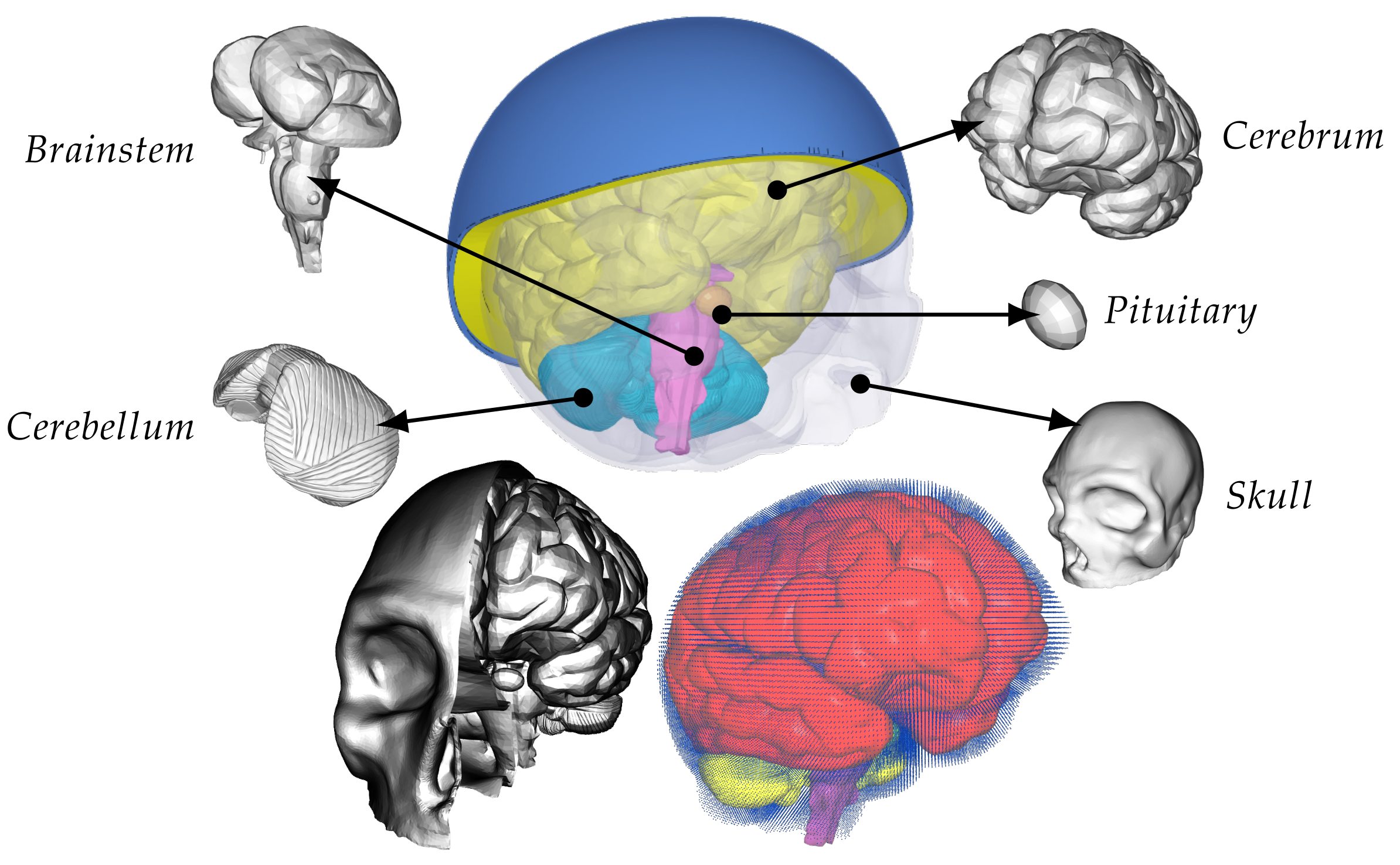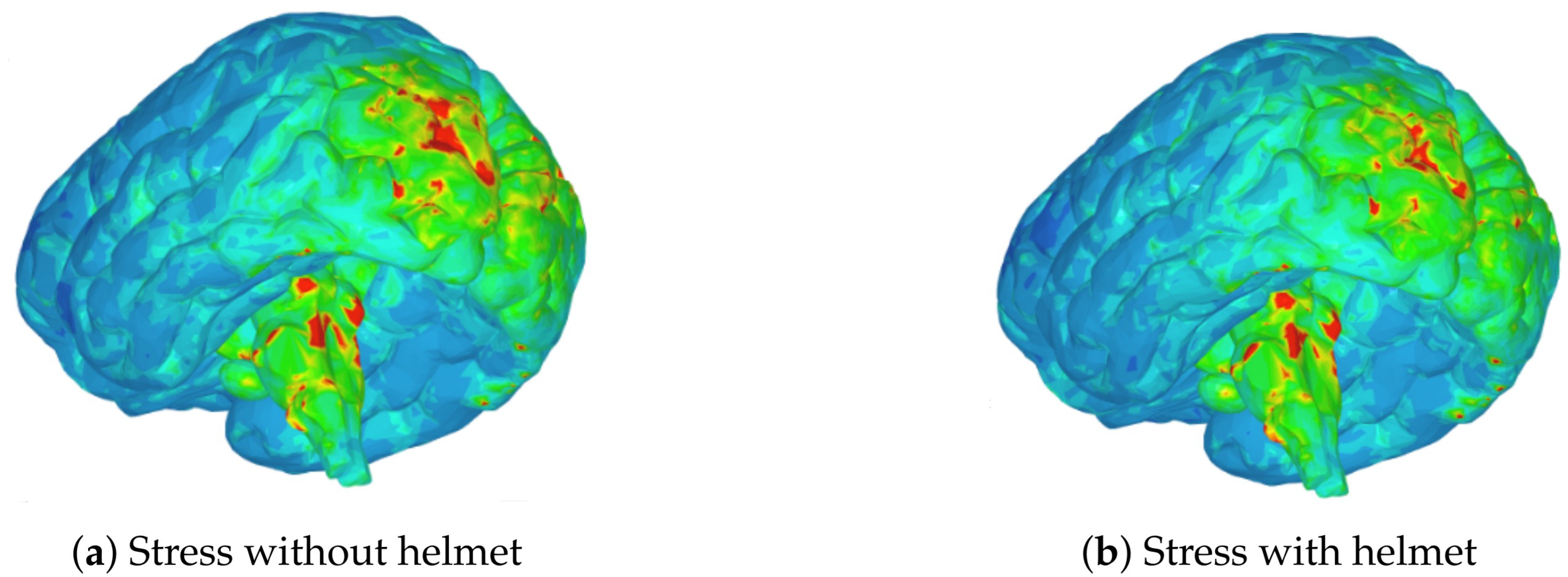Cushioning Effect of Conventional Padded Helmets on Interaction between Cerebrospinal Fluid and Brain after a Low-Speed Head Impact
Abstract
:1. Introduction
2. Materials and Methods
2.1. Geometrical Model
2.2. Computational Methods
2.3. Boundary Conditions
3. Results
3.1. Relative Motion between the Helmet and Skull
3.2. Demonstrating the Cushioning Effect of CSF
3.3. Cushioning Effect in Subsequent Waves
3.4. Comparative Analysis with and without the Helmet
4. Discussion
5. Conclusions
Author Contributions
Funding
Institutional Review Board Statement
Informed Consent Statement
Data Availability Statement
Conflicts of Interest
Abbreviations
| CTE | Chronic Traumatic Encelopathy |
| ASTM | American Society for Testing and Materials |
| CSF | Cerebrospinal Fluid |
| ANSI | American National Standards Institute |
| FSI | Fluid-Structure Interaction |
| SPH | Smoothed-Particle Hydrodynamics |
| GPU | Graphics Processing Unit |
| DICOM | Digital Imaging and Communications in Medicine |
References
- Lloyd, J.; Conidi, F. Brain injury in sports. J. Neurosurg. 2016, 124, 667–674. [Google Scholar] [CrossRef] [PubMed] [Green Version]
- Daneshvar, D.H.; Baugh, C.M.; Nowinski, C.J.; McKee, A.C.; Stern, R.A.; Cantu, R.C. Helmets and Mouth Guards: The Role of Personal Equipment in Preventing Sport-Related Concussions. Clin. Sport. Med. 2011, 30, 145–163. [Google Scholar] [CrossRef] [PubMed] [Green Version]
- Sproule, D.W.; Campolettano, E.T.; Rowson, S. Football helmet impact standards in relation to on-field impacts. Proc. Inst. Mech. Eng. Part P J. Sport. Eng. Technol. 2017, 231, 317–323. [Google Scholar] [CrossRef] [PubMed]
- Clark, J.M.; Hoshizaki, T.B.; Annaidh, A.N.; Gilchrist, M.D. Equestrian Helmet Standards: Do They Represent Real-World Accident Conditions? Ann. Biomed. Eng. 2020, 48, 2247–2267. [Google Scholar] [CrossRef] [PubMed]
- Wang, F.; Wu, J.; Hu, L.; Yu, C.; Wang, B.; Huang, X.; Miller, K.; Wittek, A. Evaluation of the head protection effectiveness of cyclist helmets using full-scale computational biomechanics modelling of cycling accidents. J. Saf. Res. 2022, 80, 109–134. [Google Scholar] [CrossRef]
- Deck, C.; Bourdet, N.; Meyer, F.; Willinger, R. Protection performance of bicycle helmets. J. Saf. Res. 2019, 71, 67–77. [Google Scholar] [CrossRef]
- Mckee, A.C.; Abdolmohammadi, B.; Stein, T.D. The neuropathology of chronic traumatic encephalopathy. In Sports Neurology; Elsevier: Amsterdam, The Netherlands, 2018; pp. 297–307. [Google Scholar] [CrossRef] [Green Version]
- Stern, R.A.; Riley, D.O.; Daneshvar, D.H.; Nowinski, C.J.; Cantu, R.C.; McKee, A.C. Long-term Consequences of Repetitive Brain Trauma: Chronic Traumatic Encephalopathy. PM R 2011, 3, S460–S467. [Google Scholar] [CrossRef]
- Mez, J.; Daneshvar, D.H.; Kiernan, P.T.; Abdolmohammadi, B.; Alvarez, V.E.; Huber, B.R.; Alosco, M.L.; Solomon, T.M.; Nowinski, C.J.; McHale, L.; et al. Clinicopathological Evaluation of Chronic Traumatic Encephalopathy in Players of American Football. JAMA 2017, 318, 360. [Google Scholar] [CrossRef] [Green Version]
- Meaney, D.F.; Smith, D.H. Biomechanics of Concussion. Clin. Sport. Med. 2011, 30, 19–31. [Google Scholar] [CrossRef] [Green Version]
- Ahmadisoleymani, S.S.; Yang, J. American Football Helmet for Preventing Concussion, a Literature Review. Procedia Manuf. 2015, 3, 3796–3803. [Google Scholar] [CrossRef] [Green Version]
- Wu, L.C.; Kuo, C.; Loza, J.; Kurt, M.; Laksari, K.; Yanez, L.Z.; Senif, D.; Anderson, S.C.; Miller, L.E.; Urban, J.E.; et al. Detection of American Football Head Impacts Using Biomechanical Features and Support Vector Machine Classification. Sci. Rep. 2017, 8. [Google Scholar] [CrossRef] [PubMed] [Green Version]
- Nelson, T. The Assigned Protection Factor According to ANSI. Am. Ind. Hyg. Assoc. J. 1996, 57, 735–740. [Google Scholar] [CrossRef] [PubMed]
- Breeze, J.; Fryer, R.N.; Russell, J. Comparing the medical coverage provided by four contemporary military combat helmets against penetrating traumatic brain injury. BMJ Mil. Health 2021, 168, 395–398. [Google Scholar] [CrossRef] [PubMed]
- Yu, X.; Ghajari, M. Protective Performance of Helmets and Goggles in Mitigating Brain Biomechanical Response to Primary Blast Exposure. Ann. Biomed. Eng. 2022, 50, 1579–1595. [Google Scholar] [CrossRef] [PubMed]
- Zhang, L.; Makwana, R.; Sharma, S. Brain Response to Primary Blast Wave Using Validated Finite Element Models of Human Head and Advanced Combat Helmet. Front. Neurol. 2013, 4, 88. [Google Scholar] [CrossRef] [Green Version]
- Op‘t-Eynde, J.; Yu, A.W.; Eckersley, C.P.; Bass, C.R. Primary blast wave protection in combat helmet design: A historical comparison between present day and World War I. PLoS ONE 2020, 15, e0228802. [Google Scholar] [CrossRef] [PubMed]
- Bradfield, C.; Vavalle, N.; DeVincentis, B.; Wong, E.; Luong, Q.; Voo, L.; Carneal, C. Combat Helmet Suspension System Stiffness Influences Linear Head Acceleration and White Matter Tissue Strains: Implications for Future Helmet Design. Mil. Med. 2018, 183, 276–286. [Google Scholar] [CrossRef] [Green Version]
- Stamp, J. Leatherhead to radio-head: The evolution of the football helmet. Smithsonian Magazine, 1 October 2012. Available online: https://www.smithsonianmag.com/arts-culture/leatherhead-to-radio-head-the-evolution-of-the-football-helmet-56585562/ (accessed on 20 March 2023).
- Karr, J.E.; Iverson, G.L.; Williams, M.W.; Huang, S.J.; Yang, C.C. Complicated versus uncomplicated mild traumatic brain injuries: A comparison of psychological, cognitive, and post-concussion symptom outcomes. J. Clin. Exp. Neuropsychol. 2020, 42, 1049–1058. [Google Scholar] [CrossRef]
- Dean, P.J.A.; Sterr, A. Long-term effects of mild traumatic brain injury on cognitive performance. Front. Hum. Neurosci. 2013, 7, 30. [Google Scholar] [CrossRef] [Green Version]
- Mattacola, C.G.; Quintana, C.; Crots, J.; Tumlin, K.I.; Bonin, S. Repeated Impacts Diminish the Impact Performance of Equestrian Helmets. J. Sport Rehabil. 2019, 28, 368–372. [Google Scholar] [CrossRef]
- Ganpule, S.; Gu, L.; Alai, A.; Chandra, N. Role of helmet in the mechanics of shock wave propagation under blast loading conditions. Comput. Methods Biomech. Biomed. Eng. 2012, 15, 1233–1244. [Google Scholar] [CrossRef] [PubMed] [Green Version]
- Bustamante, M.C.; Bruneau, D.; Barker, J.B.; Gierczycka, D.; Coralles, M.A.; Cronin, D.S. Component-Level Finite Element Model and Validation for a Modern American Football Helmet. J. Dyn. Behav. Mater. 2019, 5, 117–131. [Google Scholar] [CrossRef]
- Toma, M.; Nguyen, P.D.H. Coup-contrecoup brain injury: Fluid–structure interaction simulations. Int. J. Crashworthiness 2019, 25, 175–182. [Google Scholar] [CrossRef]
- Barber, T.W.; Brockway, J.A.; Higgins, L.S. The Density of Tissues in and about the Head. Acta Neurol. Scand. 1970, 46, 85–92. [Google Scholar] [CrossRef] [PubMed]
- Elkin, B.S.; Azeloglu, E.U.; Costa, K.D.; Morrison, B., III. Mechanical Heterogeneity of the Rat Hippocampus Measured by Atomic Force Microscope Indentation. J. Neurotrauma 2007, 24, 812–822. [Google Scholar] [CrossRef] [PubMed]
- Gefen, A.; Gefen, N.; Zhu, Q.; Raghupathi, R.; Margulies, S.S. Age-Dependent Changes in Material Properties of the Brain and Braincase of the Rat. J. Neurotrauma 2003, 20, 1163–1177. [Google Scholar] [CrossRef]
- Kruse, S.A.; Rose, G.H.; Glaser, K.J.; Manduca, A.; Felmlee, J.P.; Jack, C.R.; Ehman, R.L. Magnetic resonance elastography of the brain. NeuroImage 2008, 39, 231–237. [Google Scholar] [CrossRef] [Green Version]
- Moore, S.W.; Sheetz, M.P. Biophysics of substrate interaction: Influence on neural motility, differentiation, and repair. Dev. Neurobiol. 2011, 71, 1090–1101. [Google Scholar] [CrossRef] [Green Version]
- Lozano-Mínguez, E.; Palomar, M.; Infante-García, D.; Rupérez, M.J.; Giner, E. Assessment of mechanical properties of human head tissues for trauma modelling. Int. J. Numer. Methods Biomed. Eng. 2018, 34, e2962. [Google Scholar] [CrossRef]
- Tyler, W.J. The mechanobiology of brain function. Nat. Rev. Neurosci. 2012, 13, 867–878. [Google Scholar] [CrossRef]
- Chafi, M.S.; Dirisala, V.; Karami, G.; Ziejewski, M. A finite element method parametric study of the dynamic response of the human brain with different cerebrospinal fluid constitutive properties. Proc. Inst. Mech. Eng. Part H J. Eng. Med. 2009, 223, 1003–1019. [Google Scholar] [CrossRef] [PubMed]
- Lui, A.C.P.; Polis, T.Z.; Cicutti, N.J. Densities of cerebrospinal fluid and spinal anaesthetic solutions in surgical patients at body temperature. Can. J. Anaesth. 1998, 45, 297–303. [Google Scholar] [CrossRef] [PubMed] [Green Version]
- Gingold, R.A.; Monaghan, J.J. Smoothed particle hydrodynamics: Theory and application to non-spherical stars. Mon. Not. R. Astron. Soc. 1977, 181, 375–389. [Google Scholar] [CrossRef]
- Lucy, L.B. A numerical approach to the testing of the fission hypothesis. Astron. J. 1977, 82, 1013–1024. [Google Scholar] [CrossRef]
- Xi, R.; Luo, Z.; Feng, D.D.; Zhang, Y.; Zhang, X.; Han, T. Survey on Smoothed Particle Hydrodynamics and the Particle Systems. IEEE Access 2020, 8, 3087–3105. [Google Scholar] [CrossRef]
- Toma, M.; Chan-Akeley, R.; Arias, J.; Kurgansky, G.D.; Mao, W. Fluid–Structure Interaction Analyses of Biological Systems Using Smoothed-Particle Hydrodynamics. Biology 2021, 10, 185. [Google Scholar] [CrossRef] [PubMed]
- Toma, M.; Chan-Akeley, R.; Lipari, C.; Kuo, S.H. Mechanism of Coup and Contrecoup Injuries Induced by a Knock-Out Punch. Math. Comput. Appl. 2020, 25, 22. [Google Scholar] [CrossRef] [Green Version]
- Toma, M.; Nguyen, P.D. Fluid–structure interaction analysis of cerebrospinal fluid with a comprehensive head model subject to a rapid acceleration and deceleration. Brain Inj. 2018, 32, 1576–1584. [Google Scholar] [CrossRef]
- Toma, M.; Einstein, D.R.; Bloodworth, C.H.; Cochran, R.P.; Yoganathan, A.P.; Kunzelman, K.S. Fluid-structure interaction and structural analyses using a comprehensive mitral valve model with 3D chordal structure. Int. J. Numer. Methods Biomed. Eng. 2016, 33, e2815. [Google Scholar] [CrossRef] [Green Version]
- Telano, L.; Baker, S. Physiology, Cerebral Spinal Fluid; StatPearls Publishing: Treasure Island, FL, USA, 2022. [Google Scholar]
- Toma, M.; Dehesa-Baeza, A.; Chan-Akaley, R.; Nguyen, P.D.H.; Zwibel, H. Cerebrospinal Fluid Interaction with Cerebral Cortex during Pediatric Abusive Head Trauma. J. Pediatr. Neurol. 2020, 18, 223–230. [Google Scholar] [CrossRef]
- Santos, A.A.D.; Sorce, J.; Schonning, A.; Bevill, G. The Influence of Hard Hat Design Features on Head Acceleration Attenuation. J. Appl. Biomech. 2021, 37, 80–86. [Google Scholar] [CrossRef] [PubMed]
- Mills, N.; Gilchrist, A. Finite-element analysis of bicycle helmet oblique impacts. Int. J. Impact Eng. 2008, 35, 1087–1101. [Google Scholar] [CrossRef]
- Zhou, Z.; Li, X.; Domel, A.G.; Dennis, E.L.; Georgiadis, M.; Liu, Y.; Raymond, S.J.; Grant, G.; Kleiven, S.; Camarillo, D.; et al. The Presence of the Temporal Horn Exacerbates the Vulnerability of Hippocampus During Head Impacts. Front. Bioeng. Biotechnol. 2022, 10. [Google Scholar] [CrossRef] [PubMed]
- Toma, M. Thresholding Segmentation Errors and Uncertainty with Patient-Specific Geometries. J. Biomed. Phys. Eng. 2021, 11. [Google Scholar] [CrossRef]
- Toma, M.; Guru, S.K.; Wu, W.; Ali, M.; Ong, C.W. Addressing Discrepancies between Experimental and Computational Procedures. Biology 2021, 10, 536. [Google Scholar] [CrossRef]
- Tierney, G. Concussion biomechanics, head acceleration exposure and brain injury criteria in sport: A review. Sports Biomech. 2021, 1–29. [Google Scholar] [CrossRef]









Disclaimer/Publisher’s Note: The statements, opinions and data contained in all publications are solely those of the individual author(s) and contributor(s) and not of MDPI and/or the editor(s). MDPI and/or the editor(s) disclaim responsibility for any injury to people or property resulting from any ideas, methods, instructions or products referred to in the content. |
© 2023 by the authors. Licensee MDPI, Basel, Switzerland. This article is an open access article distributed under the terms and conditions of the Creative Commons Attribution (CC BY) license (https://creativecommons.org/licenses/by/4.0/).
Share and Cite
Syed, F.; Frankini, E.; Hurdle, K.; Garcia, J.; Chan-Akeley, R.; Toma, M. Cushioning Effect of Conventional Padded Helmets on Interaction between Cerebrospinal Fluid and Brain after a Low-Speed Head Impact. Appl. Sci. 2023, 13, 4544. https://doi.org/10.3390/app13074544
Syed F, Frankini E, Hurdle K, Garcia J, Chan-Akeley R, Toma M. Cushioning Effect of Conventional Padded Helmets on Interaction between Cerebrospinal Fluid and Brain after a Low-Speed Head Impact. Applied Sciences. 2023; 13(7):4544. https://doi.org/10.3390/app13074544
Chicago/Turabian StyleSyed, Faiz, Elisabeth Frankini, Kelsi Hurdle, Jodan Garcia, Rosalyn Chan-Akeley, and Milan Toma. 2023. "Cushioning Effect of Conventional Padded Helmets on Interaction between Cerebrospinal Fluid and Brain after a Low-Speed Head Impact" Applied Sciences 13, no. 7: 4544. https://doi.org/10.3390/app13074544





